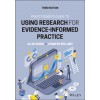Preface xiii
Acknowledgments xxi
About the Authors xxiii
PART I: Overview of Evidence-Informed Practice
Chapter 1 Introduction to Evidence-Informed Practice
Emergence of Evidence-Informed Practice
Defining Evidence-Informed Practice
Types of EIP Questions
Evidence-Informed Practice Regarding Policy And Social Justice
EIP and Black Lives Matter
Developing an Evidence-Informed Practice Process Outlook
What about unethical research?
Key Chapter Concepts
Review Exercises
Additional Readings
Chapter 2 Steps in the EIP Process
Step 1: Question Formulation
Step 2: Evidence Search
Step 3: Critically Appraising Studies and Reviews
Step 4: Selecting and Implementing the Intervention
Step 5: Monitor Client Progress
Feasibility Constraints
Strategies for Overcoming Feasibility Obstacles
But What About the Dodo Bird Verdict?
Key Chapter Concepts
Review Exercises
Additional Readings
Chapter 3 Research Hierarchies: Which Types of Research Are Best for Which Questions?
More Than One Type of Hierarchy for More Than One Type of EIP Question
Qualitative and Quantitative Studies
What Types of Research Designs Apply to What Types of EIP Questions?
Key Chapter Concepts
Review Exercises
Additional Readings
PART II: Critically Appraising Studies for EIP Questions About Intervention Effectiveness
Chapter 4 Criteria for Inferring Effectiveness: How Do We Know What Works? 71
Internal Validity
Inferring the Plausibility of Cauality
Degree of Certainty Needed in Making EIP Decisions
Measurement Issues
Statistical Chance
External Validity
Synopses of Fictitious Research Studies
Key Chapter Concepts
Review Exercises
Exercise for Critically Appraising Published Articles
Additional Readings
Chapter 5 Critically Appraising Experiments 99
Classic Pretest-Posttest Control Group Design 100
Posttest-Only Control Group Design 102
Solomon Four-Group Design 103
Alternative Treatment Designs 104
Dismantling Designs 106
Placebo Control Group Designs 107
Experimental Demand and Experimenter Expectancies 109
Obtrusive Versus Unobtrusive Observation 110
Compensatory Equalization and Compensatory Rivalry 111
Resentful Demoralization 111
Treatment Diffusion 112
Treatment Fidelity 113
Practitioner Equivalence 113
Differential Attrition 115
Synopses of Research Studies 117
Key Chapter Concepts 123
Review Exercises 124
Exercise for Critically Appraising Published Articles 125
Additional Readings 125
Chapter 6 Critically Appraising Quasi-Experiments: Nonequivalent Comparison Groups Designs 126
Nonequivalent Comparison Groups Designs 127
Additional Logical Arrangements to Control for Potential Selectivity Biases 130
Statistical Controls for Potential Selectivity Biases 134
Propensity Score Matching Using a Policy Example 144
Pilot Studies 145
Synopses of Research Studies 147
Key Chapter Concepts 152
Review Exercises 153
Exercise for Critically Appraising Published Articles 153
Additional Readings 154
Chapter 7 Critically Appraising Quasi-Experiments: Time-Series Designs and Single-Case Designs 155
Simple Time-Series Designs 156
Multiple Time-Series Designs 159
Single-Case Designs 161
Synopses of Research Studies 168
Key Chapter Concepts 174
Review Exercises 175
Exercise for Critically Appraising Published Articles 176
Additional Reading 176
Chapter 8 Critically Appraising Systematic Reviews and Meta-Analyses 177
Advantages of Systematic Reviews and Meta-Analyses 179
Risks in Relying Exclusively on Systematic Reviews and Meta-Analyses 180
Where to Start 181
What to Look for When Critically Appraising Systematic Reviews 182
What Distinguishes a Systematic Review From Other Types of Reviews? 190
What to Look for When Critically Appraising Meta-Analyses 191
Synopses of Research Studies 205
Key Chapter Concepts 209
Review Exercises 211
Exercise for Critically Appraising Published Articles 212
Additional Readings 212
PART III: Critically Appraising Studies for Alternative EIP Questions
Chapter 9 Critically Appraising Nonexperimental Quantitative Studies 215
Surveys 216
Cross-Sectional and Longitudinal Studies 228
Case-Control Studies 229
Synopses of Research Studies 231
Key Chapter Concepts 240
Review Exercises 242
Exercise for Critically Appraising Published Articles 242
Additional Readings 242
Chapter 10 Critically Appraising Qualitative Studies 243
Qualitative Observation 245
Qualitative Interviewing 247
Qualitative Sampling 250
Grounded Theory 252
Frameworks for Appraising Qualitative Studies 252
Mixed Model and Mixed Methods Studies 257
Synopses of Research Studies 258
Key Chapter Concepts 266 Review Exercises 271
Exercise for Critically Appraising Published Articles 272
Additional Readings 272
PART IV: Assessment and Monitoring in Evidence-Informed Practice
Chapter 11 Critically Appraising, Selecting, and Constructing Assessment Instruments 275
Reliability 276
Validity 280
Sensitivity 285
Feasibility 287
Sample Characteristics 288
Locating Assessment Instruments
Constructing Assessment Instruments
Synopses of Research Studies 291
Key Chapter Concepts 296
Review Exercises 297
Exercise for Critically Appraising Published Articles 298
Additional Readings 298
Chapter 12 Monitoring Client Progress 299
A Practitioner-Friendly Single-Case Design
Feasible Assessment Techniques
Using Within-Group Effect Size Benchmarks
Key Chapter Concepts 318
Review Exercises 319
Additional Readings 319
PART V: Additional Aspects of Evidence-Informed Practice
Chapter 13 Appraising and Conducting Data Analyses in Evidence-Informed Practice
Introduction
Ruling Out Statistical Chance
What Else Do You Nered To Know?
Calculating Within-Group Effect Sizes and Using Benchmarks
Conclusion
Key Chapter Concepts
Review Exercises
Additional Readings
Chapter 14 Critically Appraising Social Justice Research Studies
Introduction
Evidence-Informed Social Action
What Type of Evidence?
Participatory Action Research
Illustrations OF Other Types of Social Justice Research
Conclusion
Key Chapter Concepts
Review Exercises
Additional Readings
Glossary 335
References 345
Index 351

